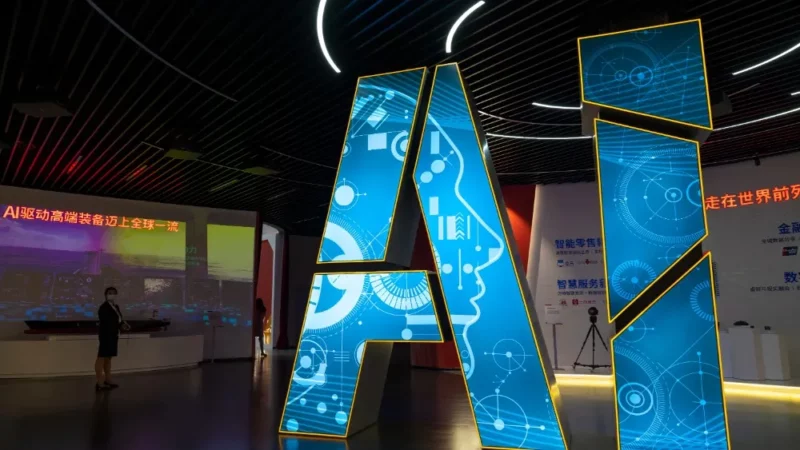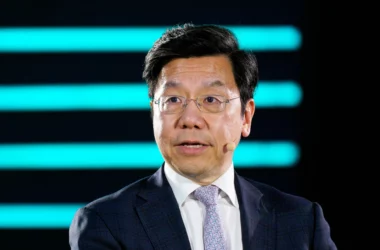From my position in Seattle, in the USA’s Pacific Northwest, I’ve had the privilege of witnessing the growing fascination with generative Artificial Intelligence (AI) firsthand, from the boom of AI startups and research centers, through to the investment of multinational corporations. But, in the ever evolving tech landscape, the Asia Pacific region stands as a dynamic hub of innovation and progress – how is the AI story being told, and heard, there?
To get an in-depth, feet-on-the-ground perspective of AI’s growing impact across the Asia Pacific region, I spoke to Sara Pereira , WE Communications ’s Regional Head of Technology. Together, we discuss AI’s promising future, how brand leaders need to treat it as an amplifier of human creativity, and the importance of a framework for ethical, responsible use.
1. WE’s recent research with USC Annenberg Center for Public Relations found that comms leaders who were considering Generative AI fall into two camps – ‘Fascinated’ and ‘Frightened’. How do you think communicators are responding to the rise of AI in Asia-Pacific?
In my conversations, what I see is that APAC senior marketing and communications leaders are definitely more fascinated than frightened. That’s optimism that I know we both share.
I’d point to three sources which support that optimism: WE Communications ‘ Fascinated and Frightened whitepaper, based on research with the USC Annenberg Center for Public Relations, PwC ‘s ‘Hopes and Fears’ whitepaper, and Adobe ‘s 2023 Digital Trends Report.
PWC’s Asia-Pacific focused research, published in August this year noted that 39% of the workforce believe that their organisation is unlikely to survive more than 10 years if they remain on their current path. They see reinvention is key to business viability, and obviously the adoption of new technology is key to allowing people and organisations to do more – to offer new products, to offer new services, to save money and to improve their day-to-day lives.
The report found that in APAC, the application of artificial Intelligence (AI) to work is seen to be mostly positive, with 41% of saying it will increase productivity and efficiency at work, and 34% viewing it as an opportunity to learn new skills. Only about 16% of respondents believe AI could replace their jobs.

According to the Adobe 2023 Digital Trends Reports, most digital marketers are facing a crunch with manpower, time, and creativity. In fact, 41% cite workflow issues as a critical barrier holding back their marketing organisations. So, what I see from speaking with marketers and communicators that people have some concerns about AI, but they also see it as a force multiplier in helping them to do more with less.
2. Looking at those in that ‘Fascinated’ camp, what do you think is fuelling their optimism? How is this playing out across the Asia-Pacific region?
I think what’s driving exploration and adoption here in APAC is that many marketers see AI as way to enhance and accelerate their creativity and marketing efforts.
This year, Microsoft commissioned global tech advisory firm Access Partnership , working alongside local partners including the Analytics & Artificial Intelligence Association of the Philippines (AAP) , the Federation of Indian Chambers of Commerce & Industry ( FICCI ), and the Center for Global Communication (GLOCOM) in Japan, to conduct country-level research on the potential economic impact of generative AI across Asia.
That research estimates a potential boost to productive capacity of US$621 billion in India, US$1.1 trillion in Japan, and US$79.3 billion in the Philippines alone, with studies ongoing in Malaysia, Indonesia and South Korea.
These country findings are consistent with other global studies—for instance, a recent report by McKinsey & Company estimates generative AI could add up to US$4.4 trillion a year to the global economy.

In general, according to PWC, Asia Pacific employees are more bullish about AI than their global counterparts. And in my view, this is true across all new technologies – workers in Asia Pacific have leapfrogged many technology changes and seem less tied to “this is the way we’ve always done it” mentality.
PWC’s research shows that workers in APAC foresee AI having mostly positive impact on their jobs with 41% saying that AI will increase productivity and efficiency at work, and 34% viewing it as an opportunity to learn new skills.
However, 22% lack confidence in their ability to acquire new AI-related skills. 16% of respondents believe that AI will replace their roles and an equal percentage feel that AI will have no impact. We saw some of this apprehension in WE’s research with USC Annenberg in the USA, too. As PR and Comms professionals continue exploring the capabilities and limitations of generative AI, getting to grips with tools and, we’ll see many of those concerns ease, the balance tilting even further towards ‘fascinated’.
Industries such as technology, media and telecommunications, as well as financial services, see the greatest potential for improved productivity through AI, while employees in health government and the public sector express the most confidence that AI will not replace their roles. I think, however, what we’ll see is AI disrupting some industries like healthcare in a really positive way, e.g. by speeding up medical diagnoses and improving participant retention in clinical trials through personalised engagement programs.
3. There’s a lot of conversation around the ethical build of AI tools by developers, and ethical deployment of them by brands and agencies. From your position in-market, where’s a good place for APAC-based brands to start?
A couple of the biggest ethical issues when it comes to artificial intelligence are AI bias and using AI to deceive or manipulate.
While data at scale has existed for a long time in Asia Pacific thanks to initiatives like the Singapore government’s Data.gov.sg or the Open Data Barometer (published by the World Wide Web Foundation), marketers have not really been able to use data at scale. And they still don’t.
In a recent piece of research that we did around what the media are talking about in Asia when it comes to using AI, we saw tried and tested use cases like chatbots for customer service transactions or using AI to find new uses for existing drugs.
But a key theme that came up was the need to ensure that the data used was unbiased.
And here I think I’d like to talk about bias in data. In my mind, there are two distinct definitions that we need make around biased data.
- Disinformation: Information that is spread with malicious intent or that inherently favours one group over another
- Misinformation: Data that is wrong – that incorrectly presents a specific view of a dataset
Marketers cannot outsource responsibility to an AI to make decisions. When we say, ‘the data says so’, it must be said with confidence. So, in order to use AI or any technology with confidence, APAC marketers should set clear objectives, ensure data quality, and maintain human oversight in how they use data sets to make decisions.
In Fascinated but Frightened, the respondents’ focus was on efficiency and automation, but as tools evolve I think we need to broaden our expectations. Yes, AI and automation will handle repetitive tasks , e.g. NLP and Sentiment Analysis. The outcomes of applying AI in this way allows us to frame narratives and messaging but it’s important that marketers still play a crucial role in strategy development, creativity, and most importantly by interpreting AI-generated insights and mapping that to inherent human bias.

The collaboration between humans and AI will become essential, with marketers focusing on higher-level tasks that require human judgment and creativity. “AI won’t take your job – it’s someone using AI who will take your job,” said economist Richard Baldwin at the recent WEF Growth Summit. And I think that’s how we need to think about AI – as a tool we use to supplement and accelerate the way we work – like email or mobile phones.
We need to move towards normalizing the use of AI in everyday tasks and understanding the limitations and opportunities that AI offers. Some of the initiatives I’ve seen here in Singapore like the AI adoption in schools to teach students the power of AI but also help them understand how to use it responsibly is an amazing way of starting to provide the next generation with the tools and understanding to use AI properly. Or introducing AI Verify – a framework and software toolkit that help industries be more transparent about their AI use. In the private sector, I also agree with Adobe’s emphasis on the need to approach GenAI innovation and use through a responsible and ethical framework that ensures, for instance, that content creators receive attribution and are compensated for their work.
4. I’ve been speaking to clients and colleagues about the need to approach AI strategically, making sure that AI is used as an amplifier for good work, not a substitute. How are you seeing businesses in APAC approach AI, thinking about how they deploy it?
One of the more exciting use cases for marketing and comms, I think, is personalisation at scale. So, delivering highly tailored experiences to individual customers – consider the effect on social impact programs like domestic violence prevention or smoking cessation. Consider predictive analytics when it comes to helping first responders in the case of a natural disaster. If we can truly make data-driven decisions, allocate resources effectively, and proactively adjust strategies to maximize the effect of what we’re doing in real time, we can really change the outcomes. And this in turn helps us as communicators manage issues, communicate more effectively and really address the pain that we may be causing to customers or communities in times of crisis.
Technologies like AI, automation, and machine learning will empower marketers to make data-driven decisions, optimize campaigns, deliver personalized experiences, but also focus on strategic and creative aspects of marketing, and on building a true connection between the complex symbol that is the brand and the people to whom it matters – customers, partners, regulators.
Brands that want to take advantage of AI-enabled technologies to reach customers, create new products or market themselves must do so with a strict ethical lens. The job marketers then have is to communicate how they are using AI to make life better, to create human connections and make the world a better place for their customers.
5. What advice would you give to PR and communications professionals who want to stay ahead of the curve in the age of AI?
Most digital marketers are already facing a crunch with manpower, time, and creativity. In fact, 41% cite workflow issues as a critical barrier holding back their marketing organisations, said Adobe’s 2023 Digital Trends Report.
If we go back to Fascinated and Frightened, respondents see a role that AI will have with content creation, with over 57% of the respondents seeing a role that AI can contribute to content creation by redirecting ‘lost’ time into creative development. Efficiency is one of the key contributions for marketeers and communication experts expect from AI tools.

We also see that senior communicators are starting to hire for skills that are aligned with using AI to make their jobs better – 87% said they were hiring for the ability to write good AI prompts and queries aka an AI whisperer – a master in the art of whispering sweet algorithms into the ears of AI. 82% said human-computer interaction knowledge and 75% said they were looking for data and analytics experience.
In reality, while marketing professionals will benefit from developing skills in data analysis, AI integration, and strategic thinking, human qualities like creativity, emotional intelligence, and adaptability will always be crucial in staying competitive and relevant in the ever-evolving marketing and communications landscape.
The debate surrounding the impact of AI in marketing and its potential for disruption versus the emergence of new jobs or the evolution of existing ones is an important and complex one. It’s clear that AI implementation in marketing can create new job opportunities. As AI technologies advance, there will be a demand for professionals skilled in AI integration, data analysis, algorithm development, and strategy formulation. New roles may emerge, such as AI marketing specialists or marketing data scientists, requiring expertise in understanding and leveraging AI capabilities.
As with any new tech opportunity, we must go back to our fundamentals: test and learn, seek counsel from experts, read and research widely. Work with your team to explore capabilities and shortfalls, and develop code of conduct for use, especially when it comes to business strategy, ethical use and data protection. Be clear with your clients and customers on how you’re using new tech, and how you’re protecting their data.
Generative AI won’t replace people. It’ll replace tasks, streamline workflows, not roles. Marketers will need to adapt and upskill themselves to work alongside AI systems, leveraging their capabilities to enhance their own effectiveness. For example, marketers will focus more on strategic decision-making, creative thinking, and customer relationship management, areas where human skills far outpace AI.
The impact of AI in marketing extends beyond the industry itself. It can influence consumer behaviour, privacy concerns, and the overall economy. As communicators, this makes our jobs bigger and more complex – and definitely more exciting and fulfilling.







